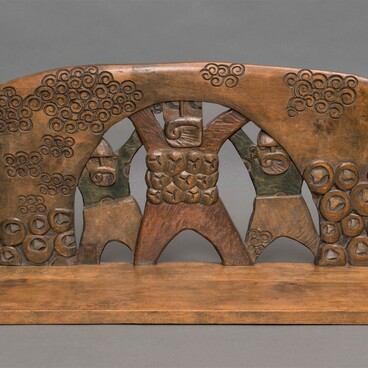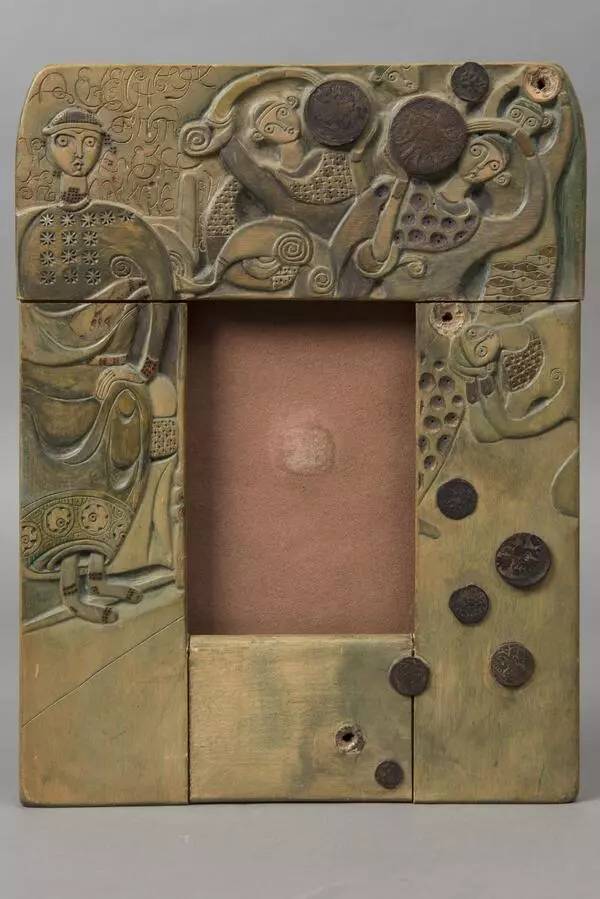In addition to small carvings, large furniture is also presented in this exhibition hall. For example, a carved buffet designed by Alexei Zinoviev.
In the interiors of the early 20th century, each living space had its own specific purpose. Moreover, different rooms could be furnished in different styles. Among the pieces of furniture that were often made in the Russian style, the most popular were dining room sets and buffets. There are few items of office furniture or living room furniture in this style, and they were intended rather for ‘gourmets’. Having a dining room in the Russian style was considered a good style.
The buffet was made in the Talashkino carpentry workshop. At the turn of the 19th and 20th centuries, Talashkino in the Smolensk region was one of the centers of Russian artistic life, comparable to Savva Mamontov’s Abramtsevo Art Club. Having set the goal of reviving peasant art crafts, Princess Maria Tenisheva and the artists she invited organized educational and industrial workshops in Talashkino, which were headed by the artist Sergei Malyutin from 1900 to 1903.
After Malyutin’s departure, Alexey Zinoviev took over the guidance of the carpentry workshop. Speaking about pieces of furniture made according to Zinoviev’s projects, art critic Sergei Makovsky noted: “Their forms do not blindly imitate peasant handicraft; they are already largely modern, our forms are in harmony with the 20th century; and at the same time, ornament, upholstery, randomness of lines, little things that at first glance are barely noticeable — in a word, everything that gives the subject of the situation its physiognomy is national, close to the people”s instinct of beauty”. There are no direct borrowings of folk art motives in Zinoviev’s works. These can be natural stylizations, mythological subjects, images from ancient art. On the buffet presented in the exposition, we see ornamental plant motifs — symmetrically located plants growing from the thickness of a tree on the doors, and in the upper part a fabulous tree and fantastic birds.
In the interiors of the early 20th century, each living space had its own specific purpose. Moreover, different rooms could be furnished in different styles. Among the pieces of furniture that were often made in the Russian style, the most popular were dining room sets and buffets. There are few items of office furniture or living room furniture in this style, and they were intended rather for ‘gourmets’. Having a dining room in the Russian style was considered a good style.
The buffet was made in the Talashkino carpentry workshop. At the turn of the 19th and 20th centuries, Talashkino in the Smolensk region was one of the centers of Russian artistic life, comparable to Savva Mamontov’s Abramtsevo Art Club. Having set the goal of reviving peasant art crafts, Princess Maria Tenisheva and the artists she invited organized educational and industrial workshops in Talashkino, which were headed by the artist Sergei Malyutin from 1900 to 1903.
After Malyutin’s departure, Alexey Zinoviev took over the guidance of the carpentry workshop. Speaking about pieces of furniture made according to Zinoviev’s projects, art critic Sergei Makovsky noted: “Their forms do not blindly imitate peasant handicraft; they are already largely modern, our forms are in harmony with the 20th century; and at the same time, ornament, upholstery, randomness of lines, little things that at first glance are barely noticeable — in a word, everything that gives the subject of the situation its physiognomy is national, close to the people”s instinct of beauty”. There are no direct borrowings of folk art motives in Zinoviev’s works. These can be natural stylizations, mythological subjects, images from ancient art. On the buffet presented in the exposition, we see ornamental plant motifs — symmetrically located plants growing from the thickness of a tree on the doors, and in the upper part a fabulous tree and fantastic birds.



